spark plugs Hyundai Equus 2016 Owner's Manual
[x] Cancel search | Manufacturer: HYUNDAI, Model Year: 2016, Model line: Equus, Model: Hyundai Equus 2016Pages: 477, PDF Size: 16.25 MB
Page 18 of 477
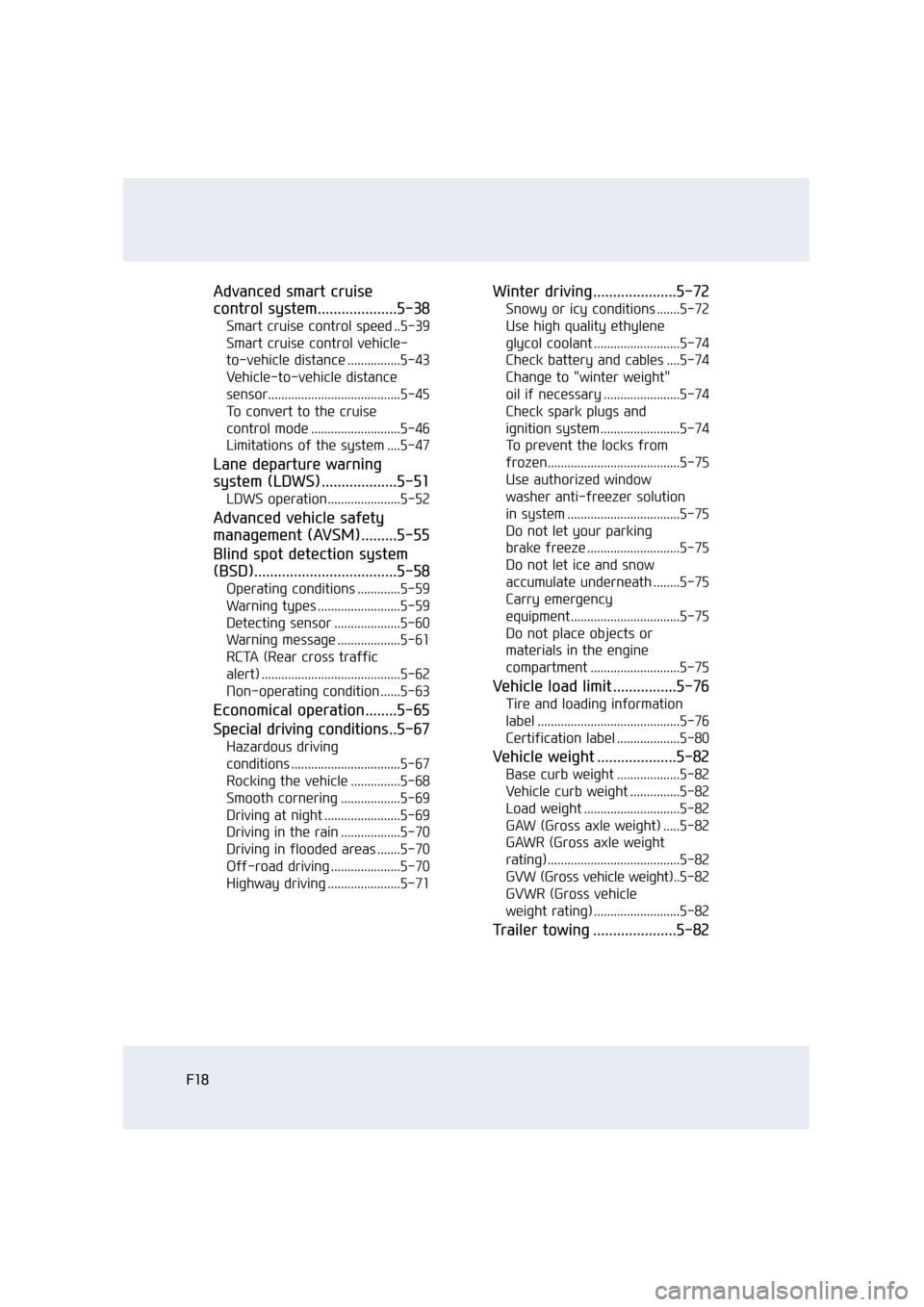
F18
Advanced smart cruise
control system....................5-38
Smart cruise control speed ..5-39
Smart cruise control vehicle-
to-vehicle distance ................5-43
Vehicle-to-vehicle distance
sensor........................................5-45
To convert to the cruise
control mode ...........................5-46
Limitations of the system ....5-47
Lane departure warning
system (LDWS) ...................5-51
LDWS operation......................5-52
Advanced vehicle safety
management (AVSM).........5-55
Blind spot detection system
(BSD)....................................5-58
Operating conditions .............5-59
Warning types .........................5-59
Detecting sensor ....................5-60
Warning message ...................5-61
RCTA (Rear cross traffic
alert) ..........................................5-62
Non-operating condition ......5-63
Economical operation........5-65
Special driving conditions.. 5-67
Hazardous driving
conditions .................................5-67
Rocking the vehicle ...............5-68
Smooth cornering ..................5-69
Driving at night .......................5-69
Driving in the rain ..................5-70
Driving in flooded areas .......5-70
Off-road driving .....................5-70
Highway driving ......................5-71
Winter driving.....................5-72
Snowy or icy conditions .......5-72
Use high quality ethylene
glycol coolant ..........................5-74
Check battery and cables ....5-74
Change to "winter weight"
oil if necessary .......................5-74
Check spark plugs and
ignition system ........................5-74
To prevent the locks from
frozen........................................5-75
Use authorized window
washer anti-freezer solution
in system ..................................5-75
Do not let your parking
brake freeze ............................5-75
Do not let ice and snow
accumulate underneath ........5-75
Carry emergency
equipment.................................5-75
Do not place objects or
materials in the engine
compartment ...........................5-75
Vehicle load limit ................5-76
Tire and loading information
label ...........................................5-76
Certification label ...................5-80
Vehicle weight ....................5-82
Base curb weight ...................5-82
Vehicle curb weight ...............5-82
Load weight .............................5-82
GAW (Gross axle weight) .....5-82
GAWR (Gross axle weight
rating) ........................................5-82
GVW (Gross vehicle weight).. 5-82
GVWR (Gross vehicle
weight rating) ..........................5-82
Trailer towing .....................5-82
Page 254 of 477
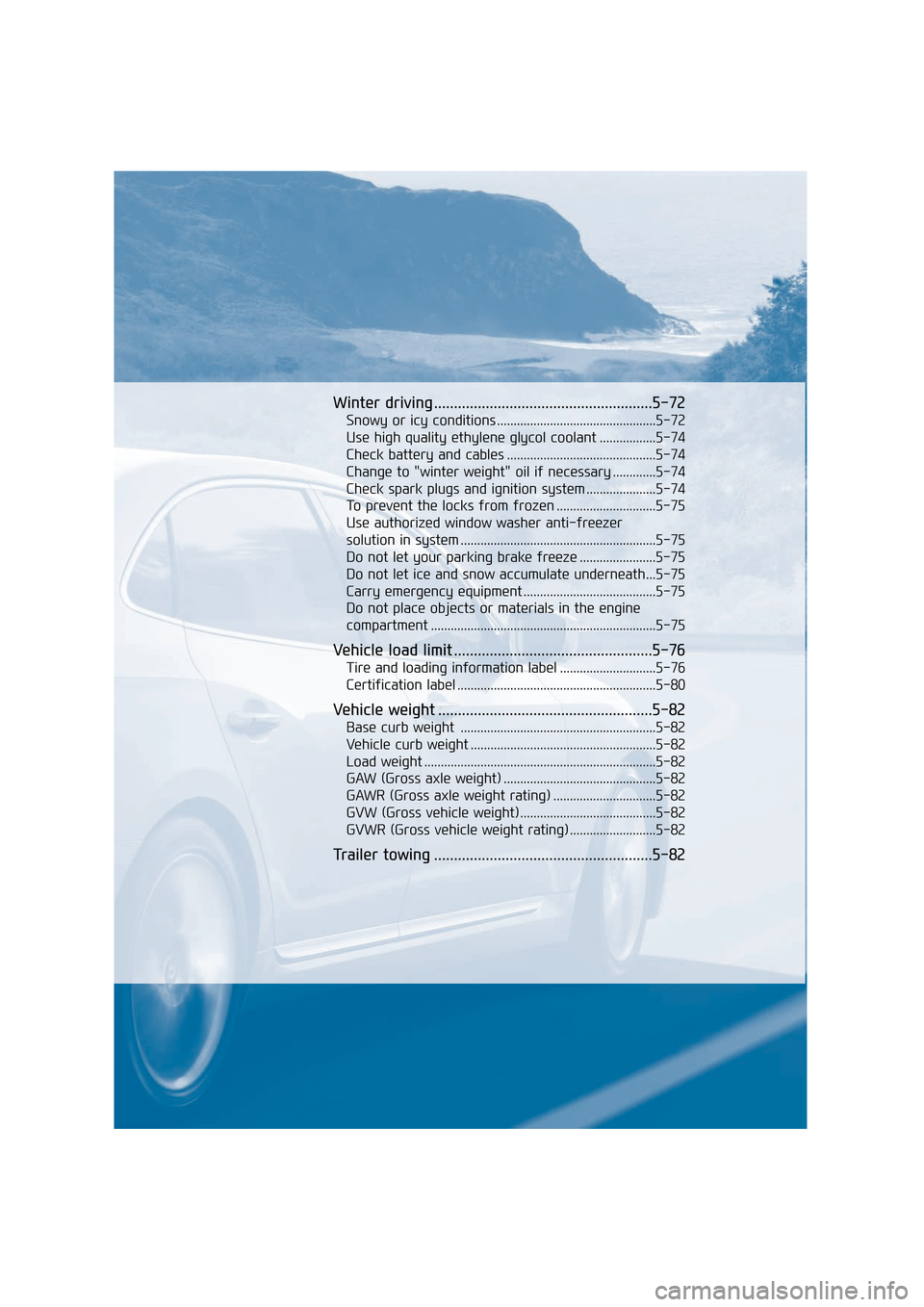
Winter driving .......................................................5-72
Snowy or icy conditions ................................................5-72
Use high quality ethylene glycol coolant .................5-74
Check battery and cables .............................................5-74
Change to "winter weight" oil if necessary .............5-74
Check spark plugs and ignition system .....................5-74
To prevent the locks from frozen ..............................5-75
Use authorized window washer anti-freezer
solution in system ...........................................................5-75
Do not let your parking brake freeze .......................5-75
Do not let ice and snow accumulate underneath...5-75
Carry emergency equipment ........................................5-75
Do not place objects or materials in the engine
compartment ....................................................................5-75\
Vehicle load limit ..................................................5-76
Tire and loading information label .............................5-76
Certification label ............................................................5-80
Vehicle weight ......................................................5-82
Base curb weight ...........................................................5-82
Vehicle curb weight ........................................................5-82
Load weight ......................................................................5-\
82
GAW (Gross axle weight) ..............................................5-82
GAWR (Gross axle weight rating) ...............................5-82
GVW (Gross vehicle weight) .........................................5-82
GVWR (Gross vehicle weight rating) ..........................5-82
Trailer towing .......................................................5-82
Page 325 of 477
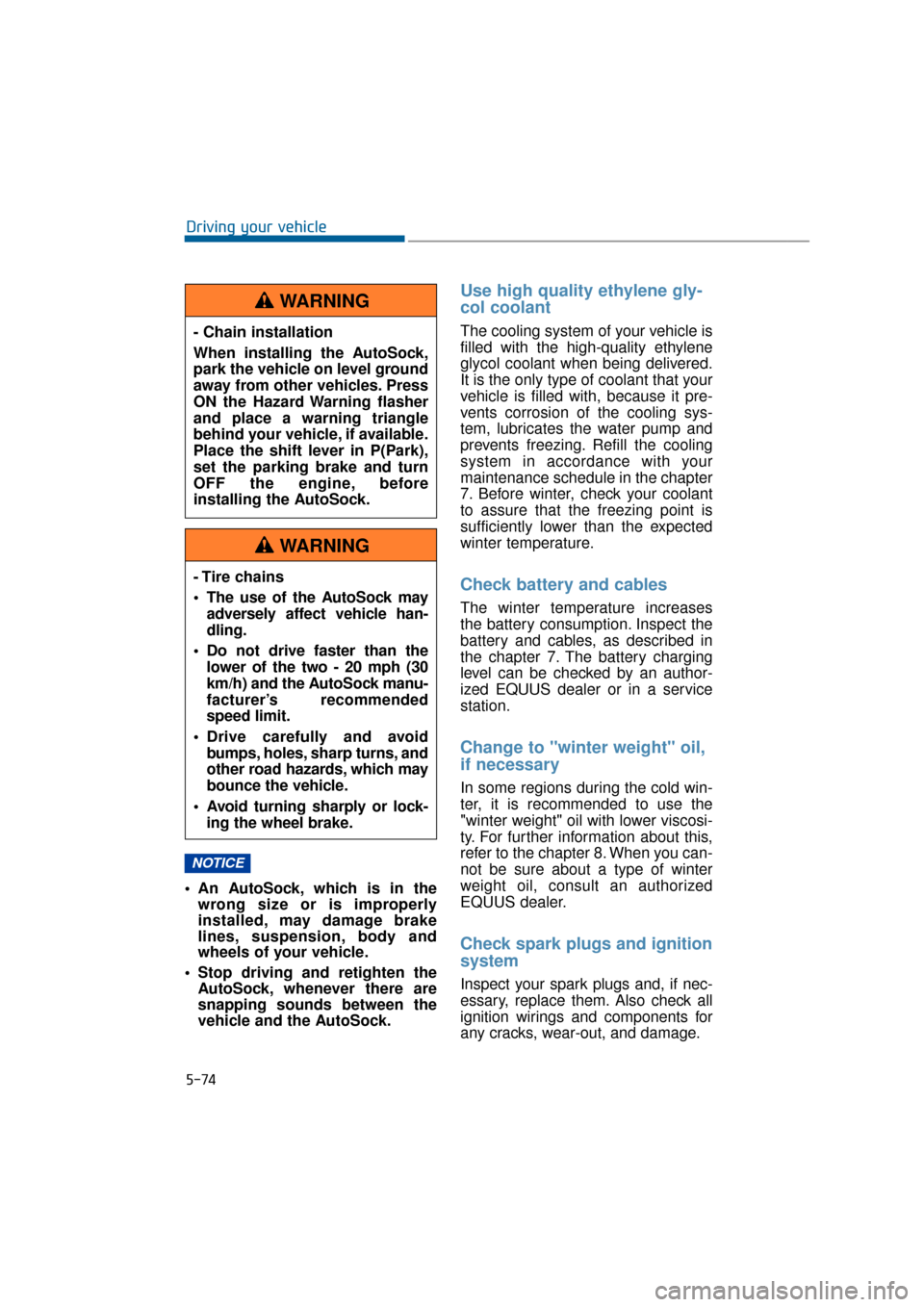
5-74
Driving your vehicle
An AutoSock, which is in the wrong size or is improperly
installed, may damage brake
lines, suspension, body and
wheels of your vehicle.
Stop driving and retighten the AutoSock, whenever there are
snapping sounds between the
vehicle and the AutoSock.
Use high quality ethylene gly-
col coolant
The cooling system of your vehicle is
filled with the high-quality ethylene
glycol coolant when being delivered.
It is the only type of coolant that your
vehicle is filled with, because it pre-
vents corrosion of the cooling sys-
tem, lubricates the water pump and
prevents freezing. Refill the cooling
system in accordance with your
maintenance schedule in the chapter
7. Before winter, check your coolant
to assure that the freezing point is
sufficiently lower than the expected
winter temperature.
Check battery and cables
The winter temperature increases
the battery consumption. Inspect the
battery and cables, as described in
the chapter 7. The battery charging
level can be checked by an author-
ized EQUUS dealer or in a service
station.
Change to "winter weight" oil,
if necessary
In some regions during the cold win-
ter, it is recommended to use the
"winter weight" oil with lower viscosi-
ty. For further information about this,
refer to the chapter 8. When you can-
not be sure about a type of winter
weight oil, consult an authorized
EQUUS dealer.
Check spark plugs and ignition
system
Inspect your spark plugs and, if nec-
essary, replace them. Also check all
ignition wirings and components for
any cracks, wear-out, and damage.
NOTICE
- Chain installation
When installing the AutoSock,
park the vehicle on level ground
away from other vehicles. Press
ON the Hazard Warning flasher
and place a warning triangle
behind your vehicle, if available.
Place the shift lever in P(Park),
set the parking brake and turn
OFF the engine, before
installing the AutoSock.
WARNING
- Tire chains
The use of the AutoSock may
adversely affect vehicle han-
dling.
Do not drive faster than the lower of the two - 20 mph (30
km/h) and the AutoSock manu-
facturer’s recommended
speed limit.
Drive carefully and avoid bumps, holes, sharp turns, and
other road hazards, which may
bounce the vehicle.
Avoid turning sharply or lock- ing the wheel brake.
WARNING
Page 336 of 477
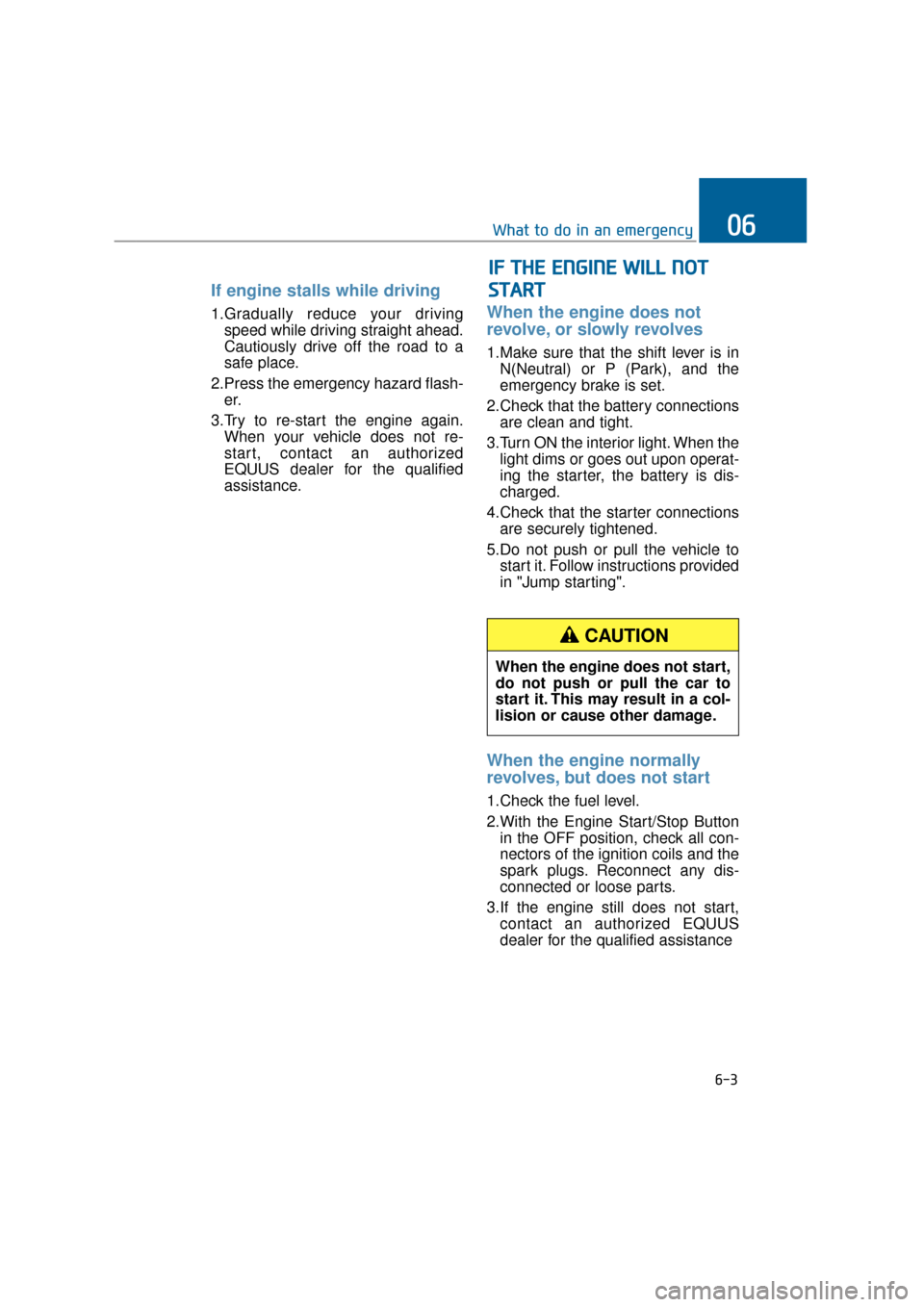
If engine stalls while driving
1.Gradually reduce your drivingspeed while driving straight ahead.
Cautiously drive off the road to a
safe place.
2.Press the emergency hazard flash- er.
3.Try to re-start the engine again. When your vehicle does not re-
start, contact an authorized
EQUUS dealer for the qualified
assistance.When the engine does not
revolve, or slowly revolves
1.Make sure that the shift lever is inN(Neutral) or P (Park), and the
emergency brake is set.
2.Check that the battery connections are clean and tight.
3.Turn ON the interior light. When the light dims or goes out upon operat-
ing the starter, the battery is dis-
charged.
4.Check that the starter connections are securely tightened.
5.Do not push or pull the vehicle to start it. Follow instructions provided
in "Jump starting".
When the engine normally
revolves, but does not start
1.Check the fuel level.
2.With the Engine Start/Stop Buttonin the OFF position, check all con-
nectors of the ignition coils and the
spark plugs. Reconnect any dis-
connected or loose parts.
3.If the engine still does not start, contact an authorized EQUUS
dealer for the qualified assistance
6-3
What to do in an emergency06
I IF
F
T
T H
H E
E
E
E N
N G
GI
IN
N E
E
W
W I
IL
L L
L
N
N O
O T
T
S
S T
T A
A R
RT
T
When the engine does not start,
do not push or pull the car to
start it. This may result in a col-
lision or cause other damage.
CAUTION
Page 373 of 477
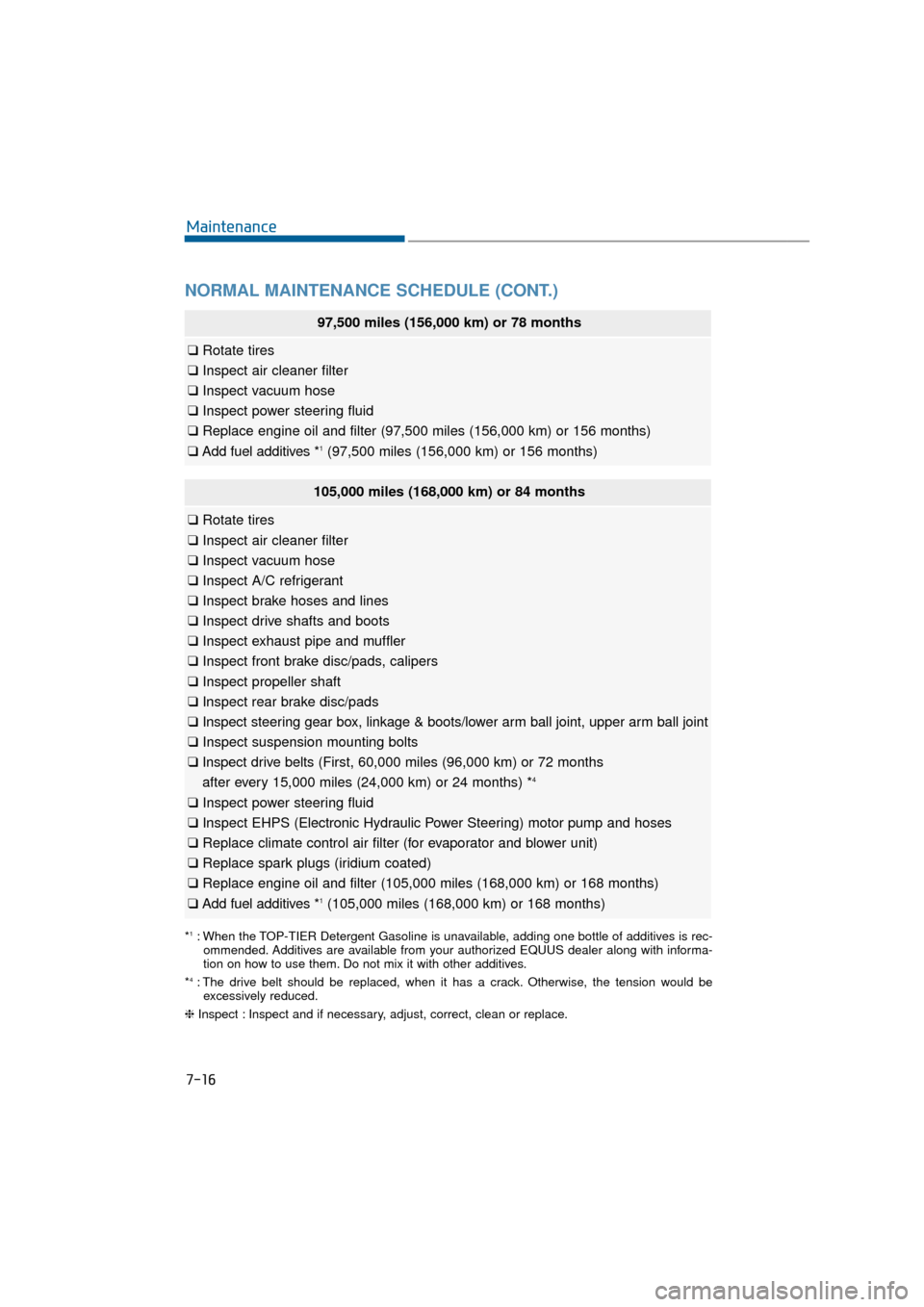
NORMAL MAINTENANCE SCHEDULE (CONT.)
7-16
Maintenance
97,500 miles (156,000 km) or 78 months
❑Rotate tires
❑ Inspect air cleaner filter
❑ Inspect vacuum hose
❑ Inspect power steering fluid
❑ Replace engine oil and filter (97,500 miles (156,000 km) or 156 month\
s)
❑ Add fuel additives *
1(97,500 miles (156,000 km) or 156 months)
105,000 miles (168,000 km) or 84 months
❑ Rotate tires
❑ Inspect air cleaner filter
❑ Inspect vacuum hose
❑ Inspect A/C refrigerant
❑ Inspect brake hoses and lines
❑ Inspect drive shafts and boots
❑ Inspect exhaust pipe and muffler
❑ Inspect front brake disc/pads, calipers
❑ Inspect propeller shaft
❑ Inspect rear brake disc/pads
❑ Inspect steering gear box, linkage & boots/lower arm ball joint, upper arm ball joint
❑ Inspect suspension mounting bolts
❑ Inspect drive belts (First, 60,000 miles (96,000 km) or 72 months
after every 15,000 miles (24,000 km) or 24 months) *
4
❑ Inspect power steering fluid
❑ Inspect EHPS (Electronic Hydraulic Power Steering) motor pump and hoses
❑ Replace climate control air filter (for evaporator and blower unit)
❑ Replace spark plugs (iridium coated)
❑ Replace engine oil and filter (105,000 miles (168,000 km) or 168 mont\
hs)
❑ Add fuel additives *
1(105,000 miles (168,000 km) or 168 months)
*1: When the TOP-TIER Detergent Gasoline is unavailable, adding one bottle of additives is rec-
ommended. Additives are available from your authorized EQUUS dealer along with informa-
tion on how to use them. Do not mix it with other additives.
*
4: The drive belt should be replaced, when it has a crack. Otherwise, the tension would be excessively reduced.
❈ Inspect : Inspect and if necessary, adjust, correct, clean or replace.
Page 379 of 477
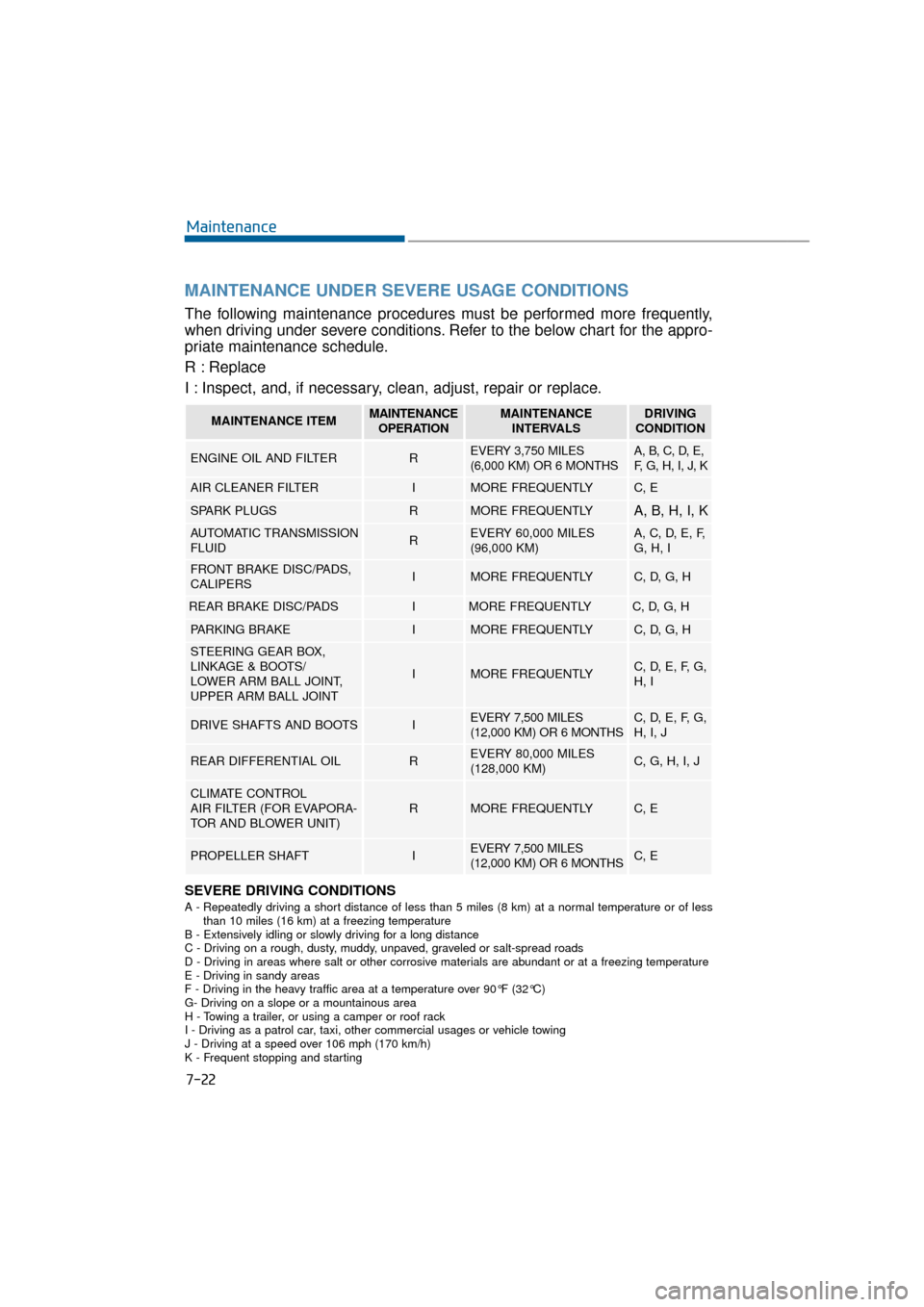
7-22
Maintenance
MAINTENANCE UNDER SEVERE USAGE CONDITIONS
The following maintenance procedures must be performed more frequently,
when driving under severe conditions. Refer to the below chart for the appro-
priate maintenance schedule.
R : Replace
I : Inspect, and, if necessary, clean, adjust, repair or replace.
SEVERE DRIVING CONDITIONS
A - Repeatedly driving a short distance of less than 5 miles (8 km) at a normal temperature or of lessthan 10 miles (16 km) at a freezing temperature
B - Extensively idling or slowly driving for a long distance
C - Driving on a rough, dusty, muddy, unpaved, graveled or salt-spread roads
D - Driving in areas where salt or other corrosive materials are abundant or at a freezing temperature
E - Driving in sandy areas
F - Driving in the heavy traffic area at a temperature over 90°F (32°C)
G- Driving on a slope or a mountainous area
H - Towing a trailer, or using a camper or roof rack
I - Driving as a patrol car, taxi, other commercial usages or vehicle towing
J - Driving at a speed over 106 mph (170 km/h)
K - Frequent stopping and starting
MAINTENANCE ITEMMAINTENANCE
OPERATIONMAINTENANCE INTERVALSDRIVING
CONDITION
ENGINE OIL AND FILTERREVERY 3,750 MILES
(6,000 KM) OR 6 MONTHSA, B, C, D, E,
F, G, H, I, J, K
AIR CLEANER FILTERIMORE FREQUENTLYC, E
SPARK PLUGSRMORE FREQUENTLYA, B, H, I, K
AUTOMATIC TRANSMISSION
FLUIDREVERY 60,000 MILES
(96,000 KM) A, C, D, E, F,
G, H, I
FRONT BRAKE DISC/PADS,
CALIPERSIMORE FREQUENTLYC, D, G, H
REAR BRAKE DISC/PADSIMORE FREQUENTLYC, D, G, H
PARKING BRAKEIMORE FREQUENTLYC, D, G, H
STEERING GEAR BOX,
LINKAGE & BOOTS/
LOWER ARM BALL JOINT,
UPPER ARM BALL JOINT
IMORE FREQUENTLYC, D, E, F, G,
H, I
DRIVE SHAFTS AND BOOTSIEVERY 7,500 MILES
(12,000 KM) OR 6 MONTHSC, D, E, F, G,
H, I, J
REAR DIFFERENTIAL OILREVERY 80,000 MILES
(128,000 KM)C, G, H, I, J
CLIMATE CONTROL
AIR FILTER (FOR EVAPORA-
TOR AND BLOWER UNIT)RMORE FREQUENTLYC, E
PROPELLER SHAFTIEVERY 7,500 MILES
(12,000 KM) OR 6 MONTHSC, E
Page 380 of 477
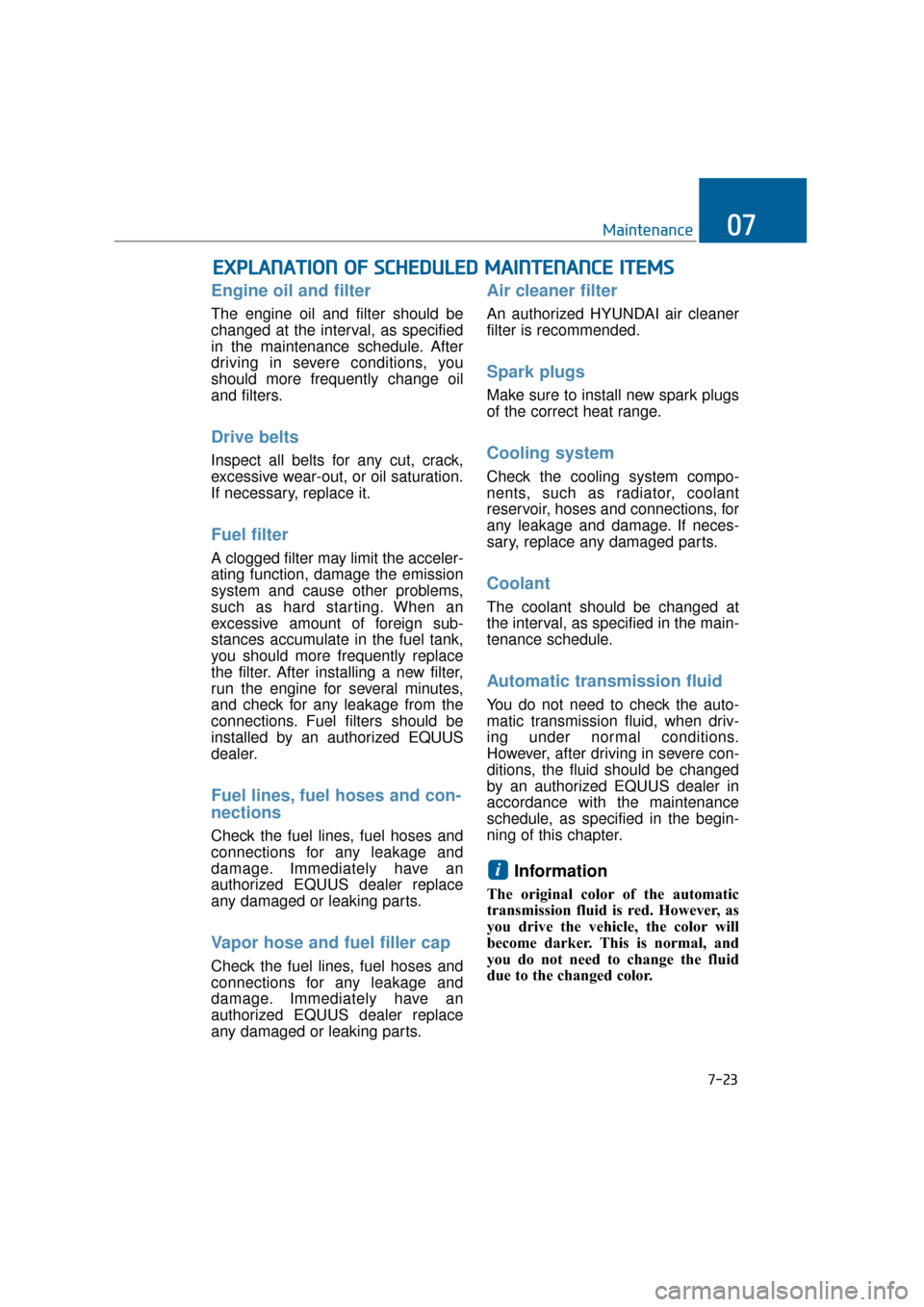
7-23
Maintenance07
E
EX
X P
PL
LA
A N
N A
AT
TI
IO
O N
N
O
O F
F
S
S C
C H
H E
ED
D U
U L
LE
E D
D
M
M A
AI
IN
N T
TE
EN
N A
AN
N C
CE
E
I
IT
T E
EM
M S
S
Engine oil and filter
The engine oil and filter should be
changed at the interval, as specified
in the maintenance schedule. After
driving in severe conditions, you
should more frequently change oil
and filters.
Drive belts
Inspect all belts for any cut, crack,
excessive wear-out, or oil saturation.
If necessary, replace it.
Fuel filter
A clogged filter may limit the acceler-
ating function, damage the emission
system and cause other problems,
such as hard starting. When an
excessive amount of foreign sub-
stances accumulate in the fuel tank,
you should more frequently replace
the filter. After installing a new filter,
run the engine for several minutes,
and check for any leakage from the
connections. Fuel filters should be
installed by an authorized EQUUS
dealer.
Fuel lines, fuel hoses and con-
nections
Check the fuel lines, fuel hoses and
connections for any leakage and
damage. Immediately have an
authorized EQUUS dealer replace
any damaged or leaking parts.
Vapor hose and fuel filler cap
Check the fuel lines, fuel hoses and
connections for any leakage and
damage. Immediately have an
authorized EQUUS dealer replace
any damaged or leaking parts.
Air cleaner filter
An authorized HYUNDAI air cleaner
filter is recommended.
Spark plugs
Make sure to install new spark plugs
of the correct heat range.
Cooling system
Check the cooling system compo-
nents, such as radiator, coolant
reservoir, hoses and connections, for
any leakage and damage. If neces-
sary, replace any damaged parts.
Coolant
The coolant should be changed at
the interval, as specified in the main-
tenance schedule.
Automatic transmission fluid
You do not need to check the auto-
matic transmission fluid, when driv-
ing under normal conditions.
However, after driving in severe con-
ditions, the fluid should be changed
by an authorized EQUUS dealer in
accordance with the maintenance
schedule, as specified in the begin-
ning of this chapter.
Information
The original color of the automatic
transmission fluid is red. However, as
you drive the vehicle, the color will
become darker. This is normal, and
you do not need to change the fluid
due to the changed color.
i